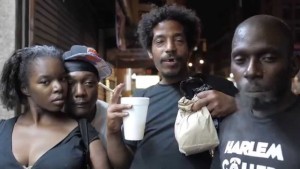 Field Niggas | Khalik Allah | USA | 2015 | 60 minutes
Field Niggas | Khalik Allah | USA | 2015 | 60 minutes
Queue at GoWatchIt for availability updates
James Kreul discusses Kahlik Allah’s Field Niggas, a vivid entry in the genre of on-the-street portraiture, shot on the corner of 125th Street and Lexington Avenue in Harlem.
Update 1/20/16: We’re always happy to be wrong. Field Niggas will make it to Madison thanks to the Micro-Wave Cinema Series. Check out their complete Spring 2016 schedule, and look for Field Niggas on Sunday, March 6, 7:00pm in 4070 Vilas Hall.
One underrepresented type of film in our first Missed Madison Film Festival has been documentaries, which is why I was particularly glad that Vincent Mollica chose to write about In My Father’s House on Wednesday. There certainly were other options available to us.
Matthew Heinmann’s Cartel Land was nominated for an Academy Award this week, and the quirky Finders Keepers made it only as close as the Milwaukee Film Festival. Two other documentaries we considered have 100% Tomatometer Ratings on Rotten Tomatoes: Sergei Loznitsa’s examination of the Ukrainian conflict, Maidan (currently streaming on Netflix), and Cosima Spender’s rousing portrait of the world’s oldest horse race, Palio.
Despite these options, I looked at Kahlik Allah’s Field Niggas for multiple reasons. First, despite also having a 100% RT rating on Rotten Tomatoes, it would never play in Madison’s commercial theaters: its too short (60 minutes) and doesn’t try to mask its digital video origins. Second, it’s loose structure aligns it with experimental filmmaking, and I particularly was reminded of Screen Test portraits by Andy Warhol and diary films by Jonas Mekas (Walden; Lost, Lost, Lost). And third, it is a successful example of a documentary subgenre which tends to be problematic when the filmmaker does not carefully consider his or her relationship to the subject: street portraits of poverty and homelessness.
There is a long tradition of on the street film portraiture, dating back to Helen Levitt, James Agee, and Janice Loeb’s In the Street (1948) and Lionel Rogosin’s On the Bowery (1956). In Field Niggas, Allah points his small digital SLR camera towards subjects near the corner of 125th Street and Lexington Avenue in Harlem. Occasionally we see him reflected in store front mirrors, but while in some films this would seem self-indulgent, here it conveys the simplicity and down-to-earth nature of Allah’s project. While similar portrait films (especially student films in the genre) falter because the filmmaker seems to be exploiting the subjects for the sake of the film, Allah presents himself as firmly integrated in that corner’s community.
Allah also takes still portraits at that corner, and we see a flipbook album of his photography suggesting that he has spent a significant amount of time there. We hear discussions that affirm that he is not just a disinterested fly-on-the-wall observer. He casually engages with the subjects and they respond in a way that demonstrates their familiarity with him. The subjects ask him questions too, sometimes putting him on the spot, and he answers as honestly as they do. Topics range from just wanting the bus to come to vivid descriptions of hunger. “I only eat every couple of days,” one subject confides. The soundtrack almost works on its own as a sound collage, including an occasional sound bed of field workers singing and African-American spiritual, which drives the images with a sense of foreboding.
There is a disjuncture, however, between the sound and image. The interviews are presented as non-synced wild sound. The images loosely match the subject interviews, but there is no attempt to simply record images of them talking. Instead, the images are slightly slow motion portraits, frequently very close up, and the subjects are often self-conscious of their role in front of the camera. It’s here that the films reminded me of Warhol’s Screen Tests: just as Warhol’s subjects had one camera roll’s worth of time to think about how they wanted to present themselves, here the subjects participate in how they are presented.
The images are amazingly sharp and saturated, given that they are shot in available light at night (I really must catch up on current camera technology). High resolution wrinkles and pores are as important here as they are in Richard Avedon’s large format portrait photography. The images can be mesmerizing as they flow in and out of focus. Allah doesn’t completely escape objectification, particularly with women wearing less clothing. But most of the subjects here, men and women, are presented with a respect that protects their dignity.
The viewer quickly becomes aware of the silent presence of the police, who seem to be monitoring those on the corner who are guilty of being poor, homeless, and black. The subjects have noticed it is getting harder to smoke K2, or synthetic weed, openly on the corner without some police harassment. The film was shot in the wake of the Erik Garner police chokehold death in 2014, a story that the corner community is well aware of and discusses explicitly late in the film. The film does not pretend to be a “neutral” or “balanced” portrait of this tension, nor does it need to be.
Field NIggas reflects a distinct point of view and perspective, but it does not explicitly argue or pontificate, except for Allah’s occasional spiritual musings in conversations. It forces us to see what we tend to ignore, and listen to voices that are usually unheard.